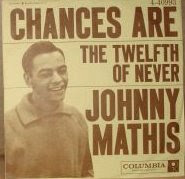 “The Twelfth of Never” is a colloquial expression referring to a hypothetical event that will never happen in the course of one’s lifetime, and one that is unlikely to occur at all. It is also the name of a frequently covered pop song that was a hit in 1957 for Johnny Mathis. Since “The Twelfth of Never” is a love song, the title refers to the moment in time when the singer will ever stop loving his beloved—in other words, never.
“The Twelfth of Never” is a colloquial expression referring to a hypothetical event that will never happen in the course of one’s lifetime, and one that is unlikely to occur at all. It is also the name of a frequently covered pop song that was a hit in 1957 for Johnny Mathis. Since “The Twelfth of Never” is a love song, the title refers to the moment in time when the singer will ever stop loving his beloved—in other words, never.
I’ll love you...Until the twelfth of Never and that’s a long, long time
Since he’ll never stop loving her, he will love her “forever.” Randy Travis sings in the song that became a No. 1 hit, “Forever And Ever, Amen,” “If you wonder how long I’ll be faithful/I’ll be happy to tell you again/I’m gonna love you forever and ever, forever and ever, amen.” As the saying goes, love, like a diamond, lasts forever (amen), except for the skeptic Arthur Lee, who perversely titled Love’s third album Forever Changes (1967), in flat contradiction to the widespread sentiment that love lasts forever, even though he often sang very much like Johnny Mathis on that album.
Thus is my preamble to a blog entry in which I originally set out to discuss songs with numbers in them, prompted by hearing Tommy Tutone’s marvelous “867-5309/Jenny” on the car radio the other day. But I discovered that at least one site has already done something like what I set out to do, so there’s really no need, as the saying goes, to reinvent the wheel. However, lists of songs with numbers in them is one thing; what they mean is, well, a horse of a different color.
There is one particular song with numbers in the title that has always especially interested me—Jimi Hendrix’s “If Six Was Nine,” on Axis: Bold as Love (1967). In 1967, when Hendrix recorded the song, he was writing within a long tradition of pop and rock songs with numbers in them—and a time about ten years after Johnny Mathis recorded “The Twelfth of Never.” Just to get a feel for the subject, I’ve listed some pop songs (including country songs) with numbers in them, in order to reveal the affinity “If Six was Nine” has with songs such as “The Twelfth of Never.” I should add that I’m reasonably confident that all of the following songs appeared before the recording of "If Six was Nine," in October 1967. The list should not be considered exhaustive by any means.
Various numbers: The Night Has a Thousand Eyes, 98.6, 19th Nervous Breakdown, Rainy Day Women #12 & 35, 1941, 18 Yellow Roses, The 59th Street Bridge Song (Feelin’ Groovy)
Highways: Route 66, Highway 61 Revisited, Highway 49
Cars: Rocket 88, 409
Girls: Sixteen Candles, You’re Sixteen, 96 Tears (note: 96=16x6)
Trains: Wreck of the Old 97
12: The Twelfth of Never
10: Ten Little Indians
9: Love Potion No. 9, Apartment No. 9, If Six was Nine
8: Eight Days a Week
7: 7 and 7 Is, 7 O’Clock News/Silent Night
6: Six O’Clock, Six O’Clock in the Morning, If Six was Nine
5: Take Five, Five O’Clock World
4: Positively 4th Street, 4th Time Around
3: Three O’Clock Rock, Wednesday Morning, 3 A.M.
2: Two Faces Have I, Just Out Of Reach (Of My Two Empty Arms), Little Deuce Coupe
1: 1-2-3, Fool #1
0: Love Minus Zero/No Limit
Mickey Newbury’s “33rd of August,” written around the same time as “If Six was Nine” (but probably after, in 1968 or '69), contains the disorientation and dislocation of songs such as “Love Potion No. 9” and “7 & 7 Is” (“I'd sit inside a bottle and pretend that I was in a can”). In these songs, number is associated with external reality, a quotidian grounding in sequential, day-to-day life, the linear world of scientific, instrumental reason. But...that dreary day-to-day reality frequently doesn’t match the internal world of the desirous imagination (or confusion, for that matter), unfettered by quotidian time. Mathematics is a matter of reason, love is a matter of desire; numbers are invoked, but they require a disinterested intellect, in contrast to what is the absolute certainty of feeling. Think of Sam Cooke’s “Wonderful World”:
Don’t know much about geography
Don’t know much trigonometry
Don’t know much about algebra
Don’t know what a slide rule is for
But I do know one and one is two,
And if this one could be with you
What a wonderful world this would be
Hence “The Twelfth of Never” points to a non-event, a moment in sequential, calendrical time that will never happen, a point in time that will never be reached. Just like the “33rd of August,” it refers to an impossible moment in time. In my view, "If Six was Nine” refers to this same impossible moment, a mathematical impossibility, the non-moment in Never when six shall be nine. For me, the song is a declaration of independence. I hear Thoreau in the song, and his statement, "If a man does not keep pace with his companions, perhaps it is because he hears a different drummer. Let him step to the music which he hears, however measured or far away."
If the sun refused to shine
I don’t mind, I don’t mind
If the mountains fell in the sea
Let it be, it ain’t me
Got my own world to live through
And I ain’t gonna copy you
Now if six turned out to be nine
I don’t mind, I don't mind
If all the hippies cut off all their hair
I don’t care, I don’t care. Dig?
‘Cause I’ve got my own world to live through
And I ain't gonna copy you
White collar conservative(s) flashin’ down the street
Pointin’ their plastic finger at me
They’re hopin’ soon my kind will drop and die
But I’m gonna wave my freak flag high. High!
Wave on, wave on
Fall mountains, just don’t fall on me
Go ahead on Mr. Businessman
You can't dress like me
[inaudible talk—see below]
Don’t nobody know what I’m talkin’ about
I’ve got my own life to live
I’m the one that’s got to die
When it’s time for me to die
So let me live my life the way I want to…
There.
Sing on brother, play on drummer
In other words, the day will never come when I'll be like you. So there.
I’ll admit my interpretation doesn’t explore the possible “occult” inferences one can find in the song, as Harry Shapiro and Caesar Glebbeek do in their book Jimi Hendrix: Electric Gypsy (St. Martin’s Griffin, 1995). I suppose my interpretation is fairly banal when compared to theirs; for instance, the reference to "Mr. Businessman" invokes, for me, anyway, the '50s novel The Man in the Gray Flannel Suit (filmed 1956), a code for the ultimate conformist, a person interested only in material acquisition. In contrast, Shapiro and Glebbeek aver that the line, “If the mountains fell in the sea,” refers to the “second world of Hopi creation mythology” (225) because Hendrix was interested in Hopi mythology (or at least read a book about it). They go on to write:
Jimi was interested in the esoteric significance of colours—the ‘vibratory’ power of colour that lies behind expressions such as ‘green with envy,’ ‘seeing red,’ and ‘feeling blue.’ As a lead-in to the last verse . . . Jimi introduces colour symbolism to reinforce the enigmatic nature of his lyrics (‘there ain’t nobody knows what I’m talkin’ about’). He speaks of ‘purple, red, yellow and green’ where (in ancient scripts) purple rays make the individual a self-ruler, red is the colour of the pioneering spirit, green is the ray of balance and harmony achieved through struggle and conflict, while yellow is the colour of creativity. The final occult inference in the song is located in the title itself: in the I Ching commentary, 6 is one of the numbers of Earth, 9 one of the numbers of Heaven.... (225-26).
I’ve never actually heard Hendrix say the four colors that Shapiro and Glebbeek refer (I can’t make out what he is saying, despite the many dozen times I've listened to the song on headphones; I do admit, however, that he is saying something), but I’ll take their word for it. Most certainly colors--in the sense of one's "true colors"--are invoked by his reference to "flag," which carries one's "standard" in a military sense, or identifying colors. "Freak flag," of course, suggests unusual colors, or perhaps even black, as in skin color. And if--as Shapiro and Glebbeek claim--in the I Ching, 6 is indeed one of the numbers of Earth and 9 one of the numbers of Heaven, then the idea of the two places ever possibly being the same names an impossible moment in time--just like "the twelfth of never."
Sunday, May 11, 2008
The Twelfth of Never
Friday, May 9, 2008
A Horse of a Different Color
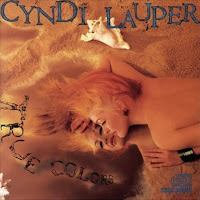 The common meaning of the colloquial expression, “Now, that’s a horse of a different color,” means, “That’s something else,” or “That’s another matter entirely.” For example, if someone says, “I thought that he's her husband but in fact he's her brother—well, now that’s a horse of a different color,” means “the fact that he’s her brother is another matter entirely.” The phrase is commonly believed to have derived from a phrase coined by Shakespeare, who wrote “a horse of that color” (Twelfth Night, Act 2, Scene 3), meaning “the same matter” rather than a different one. Eventually, though, the phrase came to mean difference rather than similarity.
The common meaning of the colloquial expression, “Now, that’s a horse of a different color,” means, “That’s something else,” or “That’s another matter entirely.” For example, if someone says, “I thought that he's her husband but in fact he's her brother—well, now that’s a horse of a different color,” means “the fact that he’s her brother is another matter entirely.” The phrase is commonly believed to have derived from a phrase coined by Shakespeare, who wrote “a horse of that color” (Twelfth Night, Act 2, Scene 3), meaning “the same matter” rather than a different one. Eventually, though, the phrase came to mean difference rather than similarity.
A number of additional colloquialisms have spun off this original expression:
—Stick to your colors, meaning hold on to your view or opinion despite what others may say.
—He’s shown his true colors, meaning his real or true self has been revealed, often used to suggest a person who’s been dissembling in a negative sense.
—He used colorful language, meaning he varied his expression, often employing ribald or raunchy word choice.
—A colorful story, meaning a story told with many lively, engaging, and picturesque details.
—A colorful personality, meaning a person whose personality or behavior is generally interesting to people.
—My view may be colored somewhat, meaning my view may be biased or prejudiced in some particular way.
Many, many popular songs have colors in their titles, but how many use the actual word “color” in their title, and in what sense? Some songs use the word "color" to refer to an actual color or colors, while other meanings of “color” are more elusive, but in general refer to what is “real” or “true,” as in Cyndi Lauper’s “True Colors.” Here are a few songs that use the word color in various ways:
Black is the Color of My True Love’s Hair – Nina Simone
Rose Colored Glasses – John Conlee
Coat of Many Colors – Dolly Parton
Color Me Once – Violent Femmes
She Comes in Colors – Love
Colors – The Oak Ridge Boys
True Colors – Cyndi Lauper
Forbidden Colors – Ryuichi Sakamoto (David Sylvain, vocal; from the soundtrack to Merry Christmas, Mr. Lawrence)
Color My World – Chicago
Colour My World – Petula Clark
The Colour of My Love – Celine Dion
Any Colour You Like – Pink Floyd
Colours – Donovan
Wednesday, May 7, 2008
The Man From Moog
 Donald Cammell and Nic Roeg’s Performance (filmed 1968; released 1970), starring Mick Jagger, James Fox, and Anita Pallenberg, is the first—and so far as I know, only—feature film in which a Moog synthesizer makes an appearance. A synthesizer named TONTO appeared in Brian De Palma’s Phantom of the Paradise (1974) but its sounds were not actually heard in the film.
Donald Cammell and Nic Roeg’s Performance (filmed 1968; released 1970), starring Mick Jagger, James Fox, and Anita Pallenberg, is the first—and so far as I know, only—feature film in which a Moog synthesizer makes an appearance. A synthesizer named TONTO appeared in Brian De Palma’s Phantom of the Paradise (1974) but its sounds were not actually heard in the film.
If records available at moogarchives.com are correct (and there's no reason to believe they are not), then the Rolling Stones did not purchase a Moog synthesizer until 3 September 1968, in other words, about five weeks prior to the end of the filming of Performance, and after the recording of Beggar’s Banquet (and therefore not, as one might have expected, immediately after the recording of 1967’s psychedelic Their Satanic Majesty Requests). And if Trevor Pinch and Frank Trocco, in their marvelous book Analog Days: The Invention and Impact of the Moog Synthesizer (Harvard University Press, 2002) are correct, then Jon Weiss, "the Man from Moog,” did not arrive in London with the Rolling Stones’ Moog synthesizer until late summer 1968, which jibes with the above date of 3 September 1968.
Apparently at the time the idea was that Mick was going to use the Moog synthesizer “as his instrument in the band” (303). At some point, soon after Jon Weiss’s arrival in London, Weiss and Jagger came up with the idea of using the synthesizer as a prop in Performance: “The Moog with its rows of knobs and dials would make a perfect addition” (303). Since, as Pinch and Trocco so astutely observe, the synthesizer was “part of the sixties apparatus for transgression, transcendence, and transformation” (305), the Moog was indeed an ideal prop for Performance, especially since its appearance coincides with Chas’s (James Fox’s) tripping on hallucinogenic mushrooms.
We first see the Moog synthesizer—which would have been an utterly unfamiliar piece of technology to the vast majority of viewers at the time—as it sits on the floor of Turner’s studio, a bewildering array of knobs and patch cables framed by fluorescent light bulbs. Turner sits on the floor before it.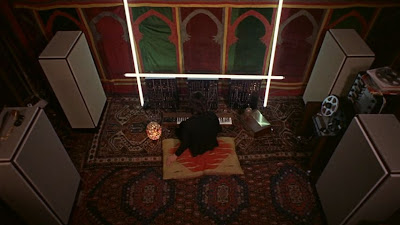
According to Pinch and Trocco, the Moog used in Performance is a Moog Series III modular synthesizer. The above frame grab from the film conveniently shows the three modules characteristic of a "modular synthesizer." Each one of the modules is essentially self-contained; there were virtually no connections within each of the three modules. The purpose of the patch cords, each with a 1/4" phone plug at the end, was to link the modules together; nothing would happen otherwise. The purpose of the patch cords was to carry one of three types of information: signals, or what sound we ultimately would hear; control, a specific (low) voltage telling the modules what to do; and triggers, or electrical pulses, telling the modules what to do at the particular moment.
The special virtue of the Moog was its durability; there was no “right” or “wrong” way to use it—no particular grouping of patches, or combination of knob settings, could damage it. On the other hand, some patch combinations and knob settings would not yield any sound, so while there may have been no right or wrong way to play around with it, if you didn’t know what you were doing, nothing would happen. At the time, therefore, someone who knew how to use it—such as Jon Weiss, "the man from Moog”—was quite valuable.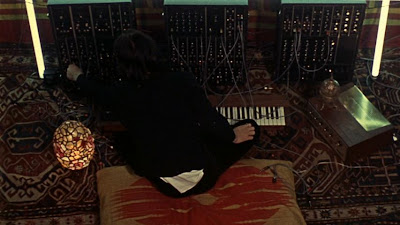
A closer view shows that a rather simple patch, or connection made between the various modules, has been made. My guess, though, is that while there is the sinister drone characteristic of the Moog on the soundtrack when Chas enters Turner’s studio, that sound was not “live” on the set, but dubbed in later. (The Moog on the soundtrack was played by Bernie Krause, one half of the synthesizer team known as Beaver and Krause.) My guess is that while Mick is shown twiddling some knobs and feigning some adjustments, the synthesizer isn’t actually turned on at all.
What Mick seems to be doing with his left hand is fiddling with the knobs of a controller section, which appears to be a Moog 901A VCO (the "voltage control oscillator," the thin panel at the extreme left) combined with a series of Moog 901B oscillator controllers (each of the panels lined up next to it to the right). His left hand seems to be turning the lower knob of a 901B unit. Directly above his left hand is the 904 series of “filter modules,” the 904A “low pass filter" and the 904B “high pass filter," the electrical systems that in fact defined the Moog and for which Robert Moog had filed patents. The second module from the left, sitting between the 904A (far left) and 904B (right) is the 904C coupler that mixed the output of the two filter modules (it could also be turned off and hence not used). Mick’s head is partially covering the Moog 901 voltage controlled oscillator (VCO), while the larger unit of knobs in the left center of the module on the far right is the Moog 960 sequential controller, which could provide a series of controlled voltages. Only one of the eight stages was active at a time, indicated by the row of lights across the top (none of which are lit, nor does the sequencer appear to be used as a part of the patch).
A better view of the sequential controller can be seen in the following frame grab; other modules in view are various low frequency oscillators, input processors, and a Moog 911 envelope generator. Note that the placement of the patch cords are not the same between the earlier stills and the one below:
The rest of the story:
1) According to Pinch and Trocco (348) the patch that the man from Moog, Jon Weiss, had set up for Mick on the synthesizer used in Performance was used to create the soundtrack for Kenneth Anger’s short film Invocation of My Demon Brother (1969), which featured a soundtrack by Mick Jagger.
2) As is well known, Mick Jagger did not take up the synthesizer—but, according to Pinch and Trocco, the Moog synthesizer originally purchased by the Stones lived on:
It was sold on to the Hansa by the Wall recording studio in Berlin, where in 1973 Christoph Franke of Tangerine Dream purchased it for $15,000. The Moog sequencer became the defining element of Tangerine Dream’s sound, and the Moog became an enduring influence on the many waves of German electronic music in the 1970s. This influence eventually provided renewed stimulus in the United States when Donna Summer’s I Feel Love (1977), produced by Giorgio Moroder in a Munich studio with the aid of a modular Moog, along with Kraftwerk’s Trans-Europe Express (1977), were taken up in black dance culture.... (305-06)
If the Performance modular synth was indeed sold to Christoph Franke of Tangerine Dream in 1973, then the first album made by that group on which that particular Moog appeared was Phaedra, recorded late in 1973 and released early in 1974, an album that is now considered an essential album of electronic music, and a breakthrough in the use of synthesizer/sequencer technology.
Monday, May 5, 2008
The Ballad of John and Yoko's Rolls
 In yesterday's blog I mentioned John Lennon's Rolls-Royce Phantom V, the car that was later repainted in psychedelic fashion (for complete information on this particular Roller, go to the following website). I also said that Lennon didn’t acquire this particular Rolls-Royce until 3 June 1965, and that it was repainted in psychedelic fashion in April 1967. I encourage readers to visit the aforementioned website to verify all of this information.
In yesterday's blog I mentioned John Lennon's Rolls-Royce Phantom V, the car that was later repainted in psychedelic fashion (for complete information on this particular Roller, go to the following website). I also said that Lennon didn’t acquire this particular Rolls-Royce until 3 June 1965, and that it was repainted in psychedelic fashion in April 1967. I encourage readers to visit the aforementioned website to verify all of this information.
I have brought up this issue because a couple of individuals have emailed me--including a third person whom we actually interviewed as part of our research--challenging my and Rebecca's assertion in our book, Donald Cammell: A Life on the Wild Side (2006), that the white Rolls-Royce used at the end of Performance (1970), the one in which Harry Flowers sits awaiting delivery of Chas ("Hello, Chas!"), and the Rolls in which Chas/Turner rides off in the film's final moments, was John Lennon's Phantom V. It was this same white Rolls, so we asserted, that was later used in the Apple Records promotional video, "The Ballad of John and Yoko" (1969). That could not be John Lennon's Rolls-Royce used in the film, we have been informed, because it was painted in psychedelic colors. The Rolls-Royce used at the end of Performance is white. I responded to these queries by saying that we did our research, and that indeed our information is correct.
It is true that three different Rollers were used in Performance: the black one, shown in the film's opening moments; the black Rolls in the garage with a "tasty finish," on which acid is poured, destroying the paint job (actually that Rolls was coated with a clear substance that reacted to the chemicals in the liquid dumped from the jug--that wasn't real acid poured on the Rolls!); and the white Rolls-Royce belonging to John Lennon used in the last sequence.
Since the issue has come up in the past, and since there may be others who haven't written me but who also think we are incorrect, I thought I'd address it, and settle the matter once and for all. I've included below a series of frame grabs from the final moments of Performance in order to fully reveal the identity of the Rolls-Royce used in the last sequence of the film.
The first still consists of a shot taken from Chas/Turner's subjective POV approaching the white Rolls...

Chas/Turner climbs in and the Rolls pulls away, revealing the front license plate, EUC 100C. Note the antenna on the roof toward the front, over the top of the windshield:
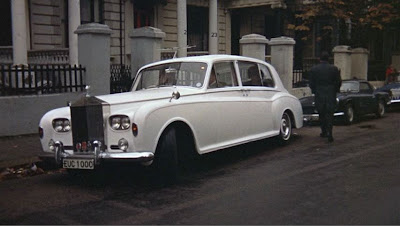
Following the 180 degree rule (editing on the axis), there is a cut to the rear of the Rolls-Royce as it pulls away from the curb and begins down the street. Again the shot reveals the license plate, EUC 100C:
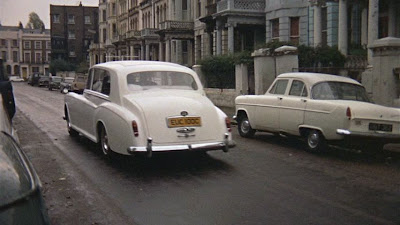
The same white Rolls used in Performance, owned by John Lennon--certainly he was wealthy enough to own more than one such luxury car--was used a few months later in the Apple Records promotional video, "The Ballad of John and Yoko." Please forgive the poor quality of the image, but here's a screen grab taken from early in the video. Note the gull-wing antenna on the roof, near the front windshield:

Here's a shot of the Rolls toward the end of the video (again I apologize for the poor quality of the image). Note the license plate, EUC 100C:
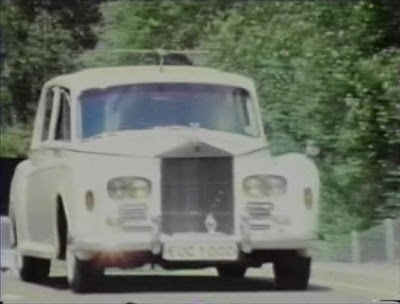
I should also add that David Cammell, the film's Associate Producer, told us that it was John Lennon's car, so I hope that all of this is proof enough that our assertion in our book about the identity of the white Rolls-Royce is correct. The equipment in Turner's "studio" was also borrowed from the Beatles' Abbey Road studio, with the exception of the Moog Series III synthesizer, which was brought over by Jon Weiss, a representative of Moog at the time.
In a subsequent blog I'll discuss what happened to the Moog synthesizer that was used in Performance.
Sunday, May 4, 2008
Moonstruck
 My previous blog entry, “The Sentimental Lunatic,” on the song "Everyone's Gone to the Moon," prompted my friend Tim Lucas to post an interesting comment, which can be found at the end of that blog (portions of it are reproduced below). His response prompted me to reflect on some issues I raised in that blog, which I’d like to expand on, briefly, with this post. For the sake of convenience I’ve reproduced Tim’s response below, splitting it into two parts in order to discuss two distinct issues. I reproduce the first half of his comment here:
My previous blog entry, “The Sentimental Lunatic,” on the song "Everyone's Gone to the Moon," prompted my friend Tim Lucas to post an interesting comment, which can be found at the end of that blog (portions of it are reproduced below). His response prompted me to reflect on some issues I raised in that blog, which I’d like to expand on, briefly, with this post. For the sake of convenience I’ve reproduced Tim’s response below, splitting it into two parts in order to discuss two distinct issues. I reproduce the first half of his comment here:
... My own take on it [“Everyone’s Gone to the Moon”] is quite different, and simpler, than yours. To my thinking, the song sketches a moment in Swinging London’s history when the scene began to darken as harder drugs than marijuana, like cocaine and heroin, came into fashion. Consequently the lyrics are organized to depict various pleasures in contrast with their own cancellation or contradiction, painting a world of plenty that still exists but is beyond the reach of people who are perpetually zonked (e.g., “gone to the moon”), with strength enough only to “lift a spoon.”
His notion that the song is a response or reaction to the darker side of the “Swinging London” scene is very plausible. In my own discussion of the song, I explored the way the song corresponded, in a rather remarkable way, to what Louis A. Sass, in his book Madness and Modernism, calls the schizophrenic Stimmung, or the onset of the radically altered perception of reality that accompanies a schizophrenic break. My own view is that while the song ostensibly offers itself as a quasi-mystical insight into the nature of reality, on closer inspection it is actually closer to an anti-epiphany, an insight into reality that may be true, but one that is terrible or nightmarish rather than positive. I therefore included some image files of paintings by the severely schizoid painter, Giorgio de Chirico, in order to provide a sort of visual equivalent of the perceptual alteration of the world that characterizes the anti-epiphany (supported musically, incidentally, by the song fading out to the discordant sounds of violins being played out of tune).
It seems to me, though, that Tim’s view and my view are not incompatible, just focused differently, his narrowly on the immediate social context in which the song was made, and mine more broadly, on the subjective response to a rapidly changing world of ever-increasing complexity, a response that Alvin Toffler would characterize in the title of a book, published only a few years later, as “future shock”:
Streets full of people all alone
Roads full of houses never home
Church full of singing out of tune
Everyone’s gone to the moon
Eyes full of sorrow never wet
Hands full of money all in debt
Sun coming out in the middle of June
Everyone’s gone to the moon
Long time ago, life had begun
Everyone went to the sun
Cars full of motors painted green
Mouths full of chocolate covered cream
Arms that can only lift a spoon
Everyone’s gone to the moon
My best estimate is that the song was recorded ca. April 1965, thus making it a bit too early to be considered psychedelia, although lyrically speaking it shares features with that form of music. Still, most psychedelia is more benign, more epiphanic, than “Everyone’s Gone to the Moon” (as evidenced by psychedelia’s transformation, as I’ve argued in previous posts on this blog, into bubblegum music). The last set of lyrics, beginning with “Cars full of motors painted green...,” seems especially directed toward a certain “social type” (following Tim’s interpretation), one whose life is composed of affected pretensions and effete mannerisms, and also one of privileged self-indulgence. Indeed, the “Swinging London” of the 60s has been characterized as an unusual mélange of slumming aristocrats and posturing hippies. Along these lines, the aforementioned lyric referring to “Cars...painted green” struck me as a possible oblique reference to John Lennon’s Rolls-Royce Phantom V which Lennon had re-painted in psychedelic colors, but according to this website, Lennon didn’t acquire the Roller until 3 June 1965, and it wasn’t repainted in psychedelic fashion until April 1967—long after “Everyone’s Gone to the Moon” was recorded.
Speaking of historical dating, I’ll return to Tim’s response. Here is most of the second half:
It could even be a criticism of then-fashionable acid rock, given the lines about how “long time ago, life had begun/everyone went to the sun,” which reads to me as an allusion to Brian Wilson, The Beach Boys, and their fun- and life-affirming brand of rock. Indeed, given the fact that The Beach Boys were contemporaneously releasing their masterpiece Pet Sounds, criticized at the time as too downbeat by some, the song could almost be interpreted as a direct criticism of the “moon” music emerging from Brian Wilson's withdrawal into coke and LSD.
Appropriately, Tim brought up a lyric of the song I hadn’t discussed, but allow me to correct him on one factual point before I continue: Pet Sounds wasn’t released until May 1966, almost a year after “Everyone’s Gone to the Moon” had charted in the UK. However, and more importantly, I think he’s correct to associate the reference, “everyone went to the sun,” with American West Coast (“surf”) music such as that played by the Beach Boys, and with California in general. For me, the song that immediately comes to mind in this context, though, and which preceded “Everyone’s Gone to the Moon,” is The Rivieras’ 1964 hit, California Sun. According to this source, “California Sun,” which appeared on the pop charts early in 1964, was one of the last chart-topping songs by an American band on the Billboard Hot 100 chart before the so-called “British Invasion.” And according to another source, "California Sun" would have reached the No. 1 spot on the pop charts if it hadn't been displaced by the Beatles' "I Wanna Hold Your Hand." If this information is correct, then the lyric, “long time ago, life had begun/everyone went to the sun,” can be understood as referring to a time prior to the “British invasion,” the time of the popularization of rock 'n' roll by Elvis (“sun” as in Sun Records, Elvis’s first record label) and American rock ‘n’ rollers such as Buddy Holly, Chuck Berry, The Rivieras, and of course the Beach Boys, displaced by (among others) the Beatles—and even, ironically, “British invasion” songs such as “Everyone’s Gone to the Moon.”
When I set out to discuss "Everyone's Gone to the Moon," I hadn't expected to encounter the richly allusive density of the lyrics. However, thanks to comments such as the one by Tim Lucas, the song is vastly richer than I had ever imagined. Although I frequently curse the amount of time it takes to maintain a blog, it's frequently the case that because I took the time to sit down and write about a particular topic, I end up learning a great deal, much more than I'd imagined, as I did in this case, when writing about the aforementioned song.
Friday, May 2, 2008
The Sentimental Lunatic
 I think Jonathan King’s “Everyone’s Gone to the Moon,” which reached the Top 4 spot in the UK pop charts in late July 1965, is a beautiful song; its aching melancholy has haunted me for decades. I must have been around eleven years old when I first heard it, and I simply can't shake it off. But what is it about? Like a startling image from a strange dream, it remains firmly lodged in my memory, because its strangeness is precisely what makes it so difficult to forget. Many people, I’ve found, have had an odd or unusual dream that they’ve never been able to forget, primarily because they’ve never been able to explain it satisfactorily, if at all.
I think Jonathan King’s “Everyone’s Gone to the Moon,” which reached the Top 4 spot in the UK pop charts in late July 1965, is a beautiful song; its aching melancholy has haunted me for decades. I must have been around eleven years old when I first heard it, and I simply can't shake it off. But what is it about? Like a startling image from a strange dream, it remains firmly lodged in my memory, because its strangeness is precisely what makes it so difficult to forget. Many people, I’ve found, have had an odd or unusual dream that they’ve never been able to forget, primarily because they’ve never been able to explain it satisfactorily, if at all.
And yet, while the song is dream-like by virtue of its apparently stubborn resistance to interpretation, it also gives one the strong impression of being a quasi-mystical insight into the nature of modern life. In addition, its writer seems distinctly modern as well, self-consciously aware of his own mode of awareness, a representative of Schiller’s “sentimental” or “reflective” poet, the kind of writer who is “self-divided because self-conscious, and so composes in an awareness of multiple alternatives, and characteristically represents not the object in itself, but the object in the subject.” (See M. H. Abrams, Natural Supernaturalism, Norton, 1971, pp. 213-14.) In his discussion of literary scholar Joseph Frank’s classic essay, “Spatial Form in Modern Literature” (1945), Louis A. Sass, in his brilliant book, Madness and Modernism (Basic Books, 1992), writes:
...Joseph Frank describes some of the ways modernist fiction attempts to deny its own temporality and approach the condition of the poetic image, defined by Ezra Pound as “that which presents an intellectual and emotional complex in an instant of time.” To achieve this sense of encompassing experiential stasis, writers use a number of devices to draw attention away from both the inherent temporality of language (which by its very nature can only represent one word after another, in a temporal sequence) and the implicit temporality of human action itself, with its purposes and causes. These include: the overwhelming of plot by mythic structures used as organizing devices (as in Joyce’s Ulysses), the movement from perspective to perspective instead of from event to event (for example, Faulkner’s The Sound and the Fury), and the use of metaphoric images as recurring leitmotifs to stitch together separate moments and thereby efface the time elapsed between them (for example, Djuna Barnes’s Nightwood). (34)
At least two of the features of modernist fiction as described above are employed in the lyrics to “Everyone’s Gone to the Moon”: the movement from one subjective perspective to another ("the object in the subject"), and the use of the recurring, metaphorical leitmotiv--the title itself. I reproduce here the lyrics in what I believe to be the accurate form:
Streets full of people all alone
Roads full of houses never home
Church full of singing out of tune
Everyone’s gone to the moon
Eyes full of sorrow never wet
Hands full of money all in debt
Sun coming out in the middle of June
Everyone’s gone to the moon
Long time ago, life had begun
Everyone went to the sun
Cars full of motors painted green
Mouths full of chocolate covered cream
Arms that can only lift a spoon
Everyone’s gone to the moon
It is necessary to go about living in the world, wrote the severely schizoid painter Giorgio de Chirico, “as if in an immense museum of strangeness.” Earlier I described “Everyone’s Gone to the Moon” as suggesting “a quasi-mystical insight,” but perhaps it is more accurately described as an anti-epiphany, which Louis A. Sass defines as, “an experience in which the familiar has turned strange and the unfamiliar familiar, often giving the person the sense of déjà vu and jamais vu, either in quick succession or even simultaneously.” (44) Sass observes that de Chirico took from Nietzsche the untranslatable German word Stimmung to describe the schizophrenic anti-epiphany, which he sees so evocatively captured in de Chirico’s painting Gare Montparnasse (Melancholy of Departure) (1914, pictured above at the top of this entry). “Everyone’s Gone to the Moon” seems very much like the experience of the schizophrenic Stimmung as described by Sass:
Unreality—“a universe of uniform precision and clarity but devoid of the dynamism, emotional resonance, and sense of human purpose that are characteristic of everyday life” (47). In order to illustrate the experience of Unreality, Sass cites the memoir of a schizophrenic named “Renee” to sufficiently capture the disturbing nature of the changed world: “It was...a country, opposed to Reality, where reigned an implacable light, blinding, leaving no place for shadow; an immense space without boundary, limitless, flat; a mineral, lunar country, cold as the wastes of the North Pole” (47).
Roads full of houses never home
Church full of singing out of tune
...
Eyes full of sorrow never wet
Hands full of money all in debt
Renee’s use of “lunar country” is provocative in this context, since the Latin word for “moon” is “luna,” the root of the word “lunatic” (slang: “loonies”), one who is crazy, insane, mad (moonstruck), suffering from “moon madness.” The association of moon and madness is, of course, invoked in Pink Floyd’s “Brain Damage” from Dark Side of the Moon (“The lunatic is on the grass”). Thus we are invited to interpret “everyone’s gone [to the moon]” as “everyone’s gone [mad],” everyone has gone “looney.”
Mere Being—Sass again refers to the memoir of “Renee,” observing: “At other times what astonished Renee...was not so much the absence of a normal sense of authenticity, emotional resonance, or functional meanings, but the very fact that objects existed at all—their Mere Being. Here we encounter an experience so very general in nature, yet at the same time so inherently concrete, so rooted in the mute thereness of the world, as nearly to defy description....such experiences can be akin . . . to the exalting feeling of wonder, mystery, and terror....” (48) (See the de Chirico painting above, Melancholy and Mystery of a Street, 1914.)
Streets, Roads, Church, Eyes, Hands, Sun, Cars...painted green, Mouths, Arms, Motors, Spoon
Fragmentation—“Objects normally perceived as parts of larger complexes may seem strangely isolated, disconnected from each other and devoid of encompassing context; or a single object may lose its perceptual integrity and disintegrate into a disunity of parts.... Another schizophrenic likened his vision of Fragmentation to being ‘surrounded by a multitude of meaningless details.’ ‘I did not see things as a whole,’ he said, ‘I only saw fragments: a few people, a dairy, a dreary house’ (49-50).
Streets full of people all alone
...
Cars full of motors painted green
Mouths full of chocolate covered cream
Arms that can only lift a spoon
Apophany—From the Greek word apophany, meaning “to become manifest.” “Once conventional meanings have faded away (Unreality) and new details or aspects of the world have been thrust into awareness (Fragmentation, Mere Being), there often emerges an inchoate sense of the as yet unarticulated significances of these newly emergent phenomena. In this “mood,” so eerily captured in both the writings and the paintings of de Chirico, the world resonates with a fugitive significance. Every detail and event takes on an excrutiating distinctness, specialness, and peculiarity—some definite meaning that always lies just out of reach, however, where it eludes all attempts to grasp or specify it” (52). In short, every single image implies an elusive “meaning” that lies "just out of reach."
E.g., Arms that can only life a spoon
What is the peculiar specialness, elusiveness, meaning of the utterance, Arms that can only lift a spoon? Decadent, effete behavior? An effect of life in zero-gravity, of living in outer space? The arm of a drug addict (the spoon associated with the intravenous administration of heroin)? Infantile behavior, in the sense that the spoon is the first utensil employed by humans ("spoon-fed")?
Additionally, Sass argues that in modernist art "the post-Kantian awareness of the limitedness of perspective engenders contradictory urges and futile yearnings, cravings to explore unimaginable viewpoints, uninhabitable mental climes," resulting in what he calls a "crossfade technique," in which "two objects or domains [are] so interfused that they seem to have merged, creating a single object that could exist nowhere but in some mental or inner universe...." (137). The entire song works this way, but is exemplified by lyrics such as:
Eyes full of sorrow never wet
Hands full of money all in debt
Sun coming out in the middle of June
Hence "Everyone's Gone to the Moon" might be best understood as a sort of cubist or futurist collage, a heteroclite mélange of "perspectival fluctuations" very similar, as Sass would argue, "to what occurs with schizophrenia" (138).


